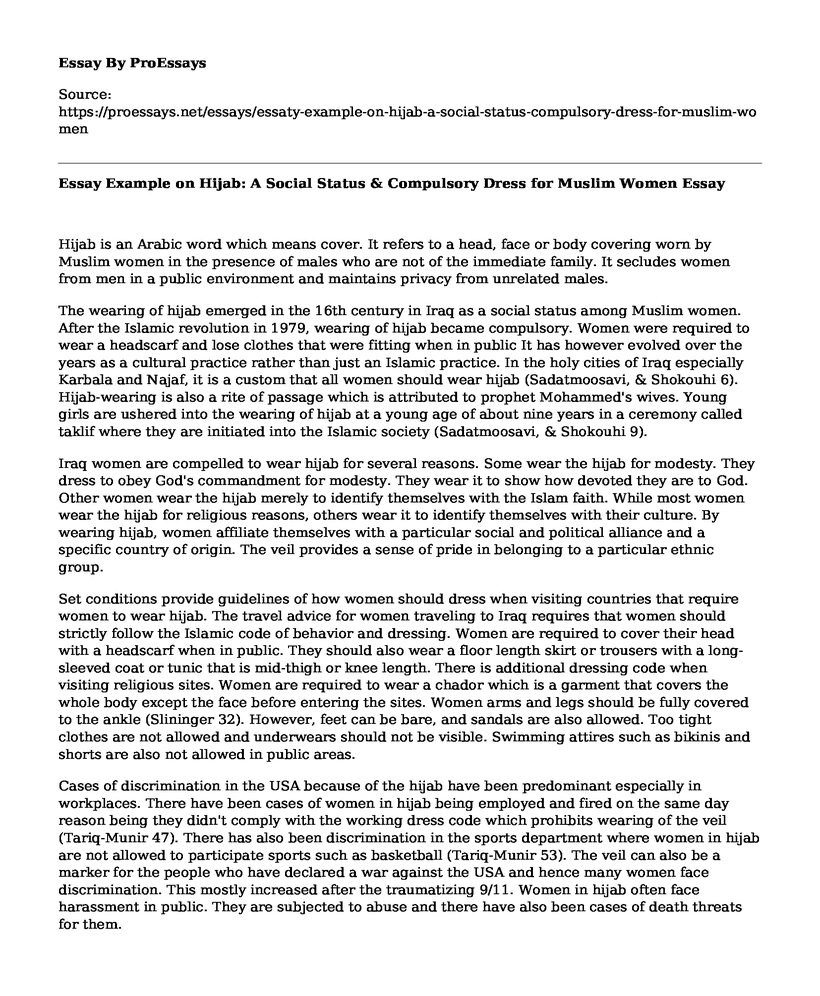Hijab is an Arabic word which means cover. It refers to a head, face or body covering worn by Muslim women in the presence of males who are not of the immediate family. It secludes women from men in a public environment and maintains privacy from unrelated males.
The wearing of hijab emerged in the 16th century in Iraq as a social status among Muslim women. After the Islamic revolution in 1979, wearing of hijab became compulsory. Women were required to wear a headscarf and lose clothes that were fitting when in public It has however evolved over the years as a cultural practice rather than just an Islamic practice. In the holy cities of Iraq especially Karbala and Najaf, it is a custom that all women should wear hijab (Sadatmoosavi, & Shokouhi 6). Hijab-wearing is also a rite of passage which is attributed to prophet Mohammed's wives. Young girls are ushered into the wearing of hijab at a young age of about nine years in a ceremony called taklif where they are initiated into the Islamic society (Sadatmoosavi, & Shokouhi 9).
Iraq women are compelled to wear hijab for several reasons. Some wear the hijab for modesty. They dress to obey God's commandment for modesty. They wear it to show how devoted they are to God. Other women wear the hijab merely to identify themselves with the Islam faith. While most women wear the hijab for religious reasons, others wear it to identify themselves with their culture. By wearing hijab, women affiliate themselves with a particular social and political alliance and a specific country of origin. The veil provides a sense of pride in belonging to a particular ethnic group.
Set conditions provide guidelines of how women should dress when visiting countries that require women to wear hijab. The travel advice for women traveling to Iraq requires that women should strictly follow the Islamic code of behavior and dressing. Women are required to cover their head with a headscarf when in public. They should also wear a floor length skirt or trousers with a long-sleeved coat or tunic that is mid-thigh or knee length. There is additional dressing code when visiting religious sites. Women are required to wear a chador which is a garment that covers the whole body except the face before entering the sites. Women arms and legs should be fully covered to the ankle (Slininger 32). However, feet can be bare, and sandals are also allowed. Too tight clothes are not allowed and underwears should not be visible. Swimming attires such as bikinis and shorts are also not allowed in public areas.
Cases of discrimination in the USA because of the hijab have been predominant especially in workplaces. There have been cases of women in hijab being employed and fired on the same day reason being they didn't comply with the working dress code which prohibits wearing of the veil (Tariq-Munir 47). There has also been discrimination in the sports department where women in hijab are not allowed to participate sports such as basketball (Tariq-Munir 53). The veil can also be a marker for the people who have declared a war against the USA and hence many women face discrimination. This mostly increased after the traumatizing 9/11. Women in hijab often face harassment in public. They are subjected to abuse and there have also been cases of death threats for them.
Muslim women have adapted to cultures to new cultures when visiting non-Muslim countries. There have been variations in how Muslim women practice their religion in the USA. Islam women have been seen without the hijab in public. There are also women who have chosen to identify themselves with America as their primary identity (Tariq-Munir 22). However, Muslim women take longer to integrate themselves with a new culture compared to non-Muslim women.
Wearing of hijab in the Muslim culture is essential as it identifies them to their culture and religion. It gives women the pride of belonging to their country. Hijab provides a spark for the women who wear it and provides a sense of belonging.
Works cited
Sadatmoosavi, Z. & Shokouhi, M., A. "HIJAB OF WOMEN IN ISLAMIC CIVILIZATIONHISTORY." World Congress for Islamic History and Civilization, WOCIHAC 2011,2011, pp. 1-11, DOI: 10.0004/foo.bar.
Tariq-Munir, E. "The Dynamics of Wearing hijab for Muslim American Women in the UnitedStates." A thesis submitted to the graduate faculty in partial fulfillment of therequirements for the degree of MASTER OF SCIENCE, 2014, pp. 1-70, doi:10.31274/etd-180810-3621.
Slininger, S. "Veiled Women: Hijab, Religion, and Cultural Practice," 2014, pp. 1-78. Retrievedfrom: https://www.eiu.edu/historia/Slininger2014.pdf
Cite this page
Essay Example on Hijab: A Social Status & Compulsory Dress for Muslim Women. (2022, Dec 27). Retrieved from https://proessays.net/essays/essaty-example-on-hijab-a-social-status-compulsory-dress-for-muslim-women
If you are the original author of this essay and no longer wish to have it published on the ProEssays website, please click below to request its removal:
- Gender Pay Gap in European Union Essay
- Paper Example on Effects of Parent's Alcoholism on Children and Methods of Stopping the Cycle
- Cause and Effect Essay on Sexual Harassment in the Army
- Basic Information About Barcelona, Spain That the Expatriate Should Know
- Comparison of Hinduism and Buddhism Religions Influence on South Asian Life Essay
- Essay on Deaf Man Files Discrimination Case Against Oakland County
- Alcohol Abuse Among Teens: Adverse Effects on Health & Future - Report Sample







